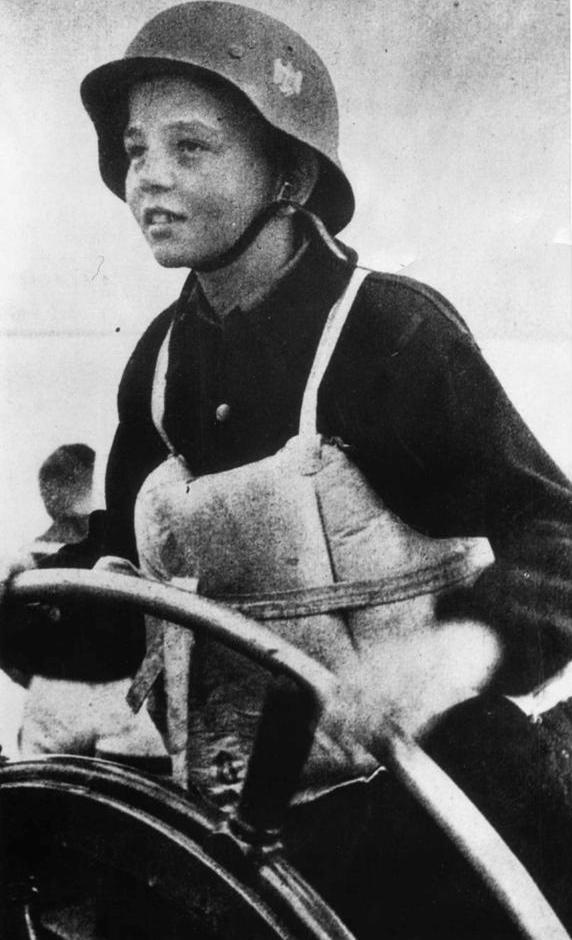
German Kriegsmarine Units: Patrol Craft

Figure 1.--We are unsure how to interpret this photograph.. We doubt as the caption suggests that the boy here was a crew member. We think he may be the captain's son or part of a visiting group of Deutsche Jugend (DJ) boys, the juniot division of the Hitler Youth. The wire service caption read, "NAZI schoolboy at the helm: A Nazi youngster, who appears to be of 'grammar' [primary] school age, mans the helm of a German coastal patrol vessel. This opicture, received through a neutral source, backs up reports that the enemy's manpower shortage is so acute that young boys are being recruited for sea training on patrol vessels and are being used to man anti-aircraft guns. [It was true that HJ boys, but not usually DJ boys, were being used to man FLAK batteries.] The German Transocean Agency has broadcast a report that millions of men are being recruited for a 'strategic reserce' from World War I veterans and boys of the Hitler Youth." The photograph was dated April 23, 1943. It is also true that a strategic reserve was being organized as part of an effort to build a home guard--Operation Valkyrie. The bomb plotters tried to use this force to seize contol of Germany from the NAZIs (July 1944).
|
|
We do not have much information on German coastal patrol boats yet. Unlike the larger craft, they were not subject the Versailles Treaty restrictions. While there were no restrictions om construction, they were not hat the German admirals wanted and later Hitler. They wanted bug-gun battleships. We notice references to three patrol craft used by the Kreigsmarine in World War II: Räumboote--R boats (1929-45), E-boats (1927-45), and Patroullienboot Ausland--PA (1943-45). Unlike the capital ships and later U-boats, they did not attract Hitler's interest. The 41 meter (m) Räumboote (R boat) was the surface ship built in the greatest numbers by the Germans before and during World War II. The were designed as minesweepers, but used for a variety of assignments. The Germans built 424 of these boats and used then in every theater including the Atlantic (coast of France), the North Sea, Baltic, Mediterranean and the Black Sea. With the Kreigsmarine's destroyers sunk or damaged after Norway, these small boats could have played an important role in Operation Sealion. The Kreigsmarine used them for convoy escort, coastal patrol, mine sweeping, mine laying, and air-sea rescue. Perhaps the best known German patrol boat was the 33-m Schnellboot (E-boats). These fast motor torpedo boats were called Schnellboote German (S-boats) for 'fast boats' by the Germans, E-boat was the British designation, probably meaning enemy boats. The E-boats were incredibly fast, cruising at 40 or 50 knots. The wooden construction meant it could pass through the extensive magnetic minefields laid in the Channel and North Sea. It outclassed the better known American PT boats as well as the British motor torpedo boats (MTB). It could operate in the open sea and had a range of about 700 nautical miles. In response the British developed an upgraded MTBs using the Fairmile 'D' hull design. The Americans withdrew the PT-boats from European service, but they were used with considerable success in the Pacific. The most notable E-boat action was off Devon when a group of E-boats caught American landing craft practicing for the D-Day invasion--Operation Tiger (April 1944). Some 638 Army and Navy personnel were killed. The action was hushed up at the time. On D-Day, however, the E-boats were not a factor. The Allied invasion armada crossed the Channel before the Kreigsmarine detected it and could deploy their E-boats from Cherbourg. The 62-m Patroullienboot Ausland were the largest of the German coastal patrol craft. They actually ships being built by the French at the time of the German invasion (1940). They were seized by the Germans who attempted tom complete construction for the Kriefsmarine. Work progressed slowly, apparently as a result of reluctance or even actual sabotage by French workers. Only four were eventually completed. The Germans commissioned them and deployed them as as escort vessels (1943–44). Three were sunk by the RAF (1944). The Germans sunk the fourth as a block ship at Le Havre after the D-Day landings.
HBC

Navigate the HBC World War II opages:
[Return to Main Kriegsmarine World War II page]
[Return to Main German Navy page]
[Return to Main military force page]
[Return to Main German military force page]
[Return to Main German World War II military organization page]
[Return to Main German World War II page]
[Biographies]
[Campaigns]
[Children]
[Countries]
[Deciding factors]
[Diplomacy]
[Geo-political crisis]
[Economics]
[Home front]
[Intelligence]
[POWs]
[Resistance]
[Race]
[Refugees]
[Technology]
[Bibliographies]
[Contributions]
[FAQs]
[Images]
[Links]
[Registration]
[Tools]
[Return to Main World War II page]
[Return to Main war essay page]
Created: 5:37 AM 10/17/2013
Spell checked: 3:49 PM 10/17/2013
Last updated: 3:49 PM 10/17/2013



